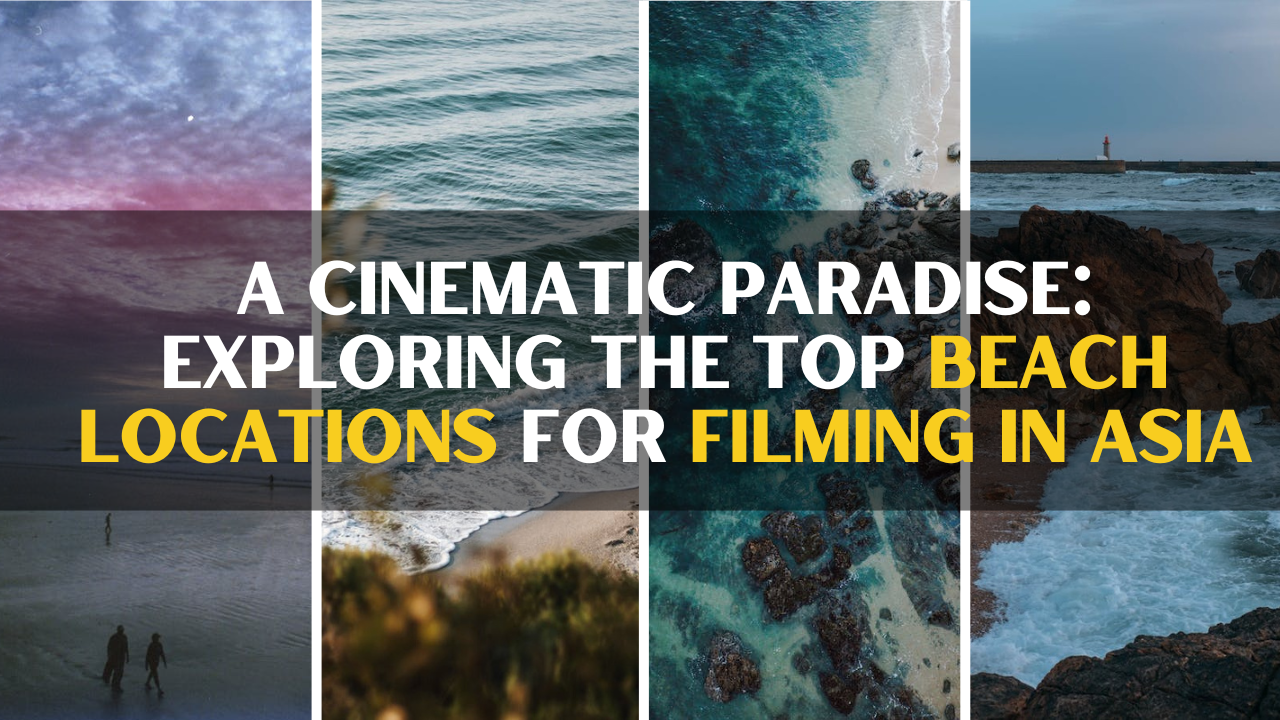Beach locations have always been a favorite choice for filmmakers seeking to capture stirring decor and produce indelible moments on the tableware screen. With their stunning natural beauty, different geographies, and vibrant societies, beach locations offer an endless array of possibilities for filmmakers. In this composition, we will claw into the world of beach filming locations, with a particular focus on the top beach locations in Asia. Whether you are a seasoned filmmaker or an aspiring director, get ready to be inspired by the cinematic paradise that awaits you.
Beach Locations Where Dreams Meet Reality
Beach locations have the unique capability to transport observers to a world where dreams meet reality. The combination of sun-kissed props, demitasse-clear waters, and stunning geographies produce an air that’s both witching and visually striking. Rephotographing on a beach allows filmmakers to showcase the raw beauty of nature while setting the stage for dramatic scenes and romantic narratives. From serene tropical strands with win-fringed props to rugged littoral escarpments offering stirring lookouts, each beach position has its own distinct charm and character.
Filming in Asia A Treasure Trove of Possibilities
Asia, with its rich artistic heritage and different geographies, has surfaced as a hotspot for filmmakers from around the globe. The mainland offers an inconceivable range of beach locations that can feed colorful film stripes and narratives. Whether you are looking for an isolated paradise or a bustling littoral megacity, Asia has it all.
Thailand Phuket:
Phuket, located in Thailand, is a famed beach destination that has attracted multitudinous filmmakers over time. Its pristine strands, demitasse-clear waters, and lush tropical surroundings make it an ideal position for shooting flicks. From the notorious Patong Beach to the isolated Kata Noi Beach, Phuket offers a different range of settings for filmmakers to explore.
Indonesia Bali:
Bali, frequently appertained to as the” Island of the Gods,” is a paradise for filmmakers seeking stunning beach locations. Its graphic bank, stormy geographies, and vibrant culture have made it a popular choice for both original and transnational film products. Bali’s iconic strands, similar to Kuta, Seminyak, and Uluwatu, offer stirring backgrounds for filmmakers looking to capture the substance of tropical beauty.
Sri Lanka Mirissa Beach:
Mirissa, Located on the southern seacoast of Sri Lanka, Mirissa Beach is known for its pristine flaxen props, clear turquoise waters, and laid-back atmosphere. It offers a tropical paradise air, with win trees swaying in the breath and traditional fishing boats dotting the bank. The beach also provides openings for Goliath watching, as Mirissa is a popular spot for observing blue jumbos and dolphins.
Philippines Palawan:
Palawan, a fiefdom in the Philippines, boasts some of the most pristine and untouched beach locations in Asia. Its stunning turquoise waters, limestone escarpments, and isolated islets produce a surreal setting for filming. The graphic El Nido and Coron are among the top beach locations in Palawan, furnishing filmmakers with a cornucopia of natural beauty to capture on camera.
Maldives Paradise on Earth:
The Maldives, known for its luxury resorts and turquoise lagoons, is a cinematic paradise for filmmakers. With its white flaxen strands, vibrant coral reefs, and overwater estates, the Maldives offers a unique mix of natural beauty and luxury. Filming in the Maldives provides an occasion to showcase the fantastic appeal of this tropical destination.
Havelock Island, Andaman and Nicobar Islets, India:
Havelock Island is part of the Andaman and Nicobar islets in the Bay of Bengal. It’s known for its stunning Radhanagar Beach, which has been ranked among the world’s stylish strands. The beach features a fine white beach, turquoise waters, and lush verdure, furnishing a tropical paradise setting.
Goa, India:
Goa is a littoral state in western India, known for its beautiful strands along the Arabian Sea. From bustling and lively strands like Calangute and Baga to the serene and isolated stretches of Palolem and Agonda, Goa offers a blend of vibrant and tranquil beach settings.
Hạ Long Bay, Vietnam:
Hạ Long Bay, Vietnam is a UNESCO World Heritage Site and a popular trip destination in Quảng Ninh Province, Vietnam. Hạ Long Bay is a center of a larger zone which includes Bai Tu Long Bay to the northeast, and Cát Bà Island to the southwest. These larger zones partake in similar geological, geographical, geomorphological, climate, and cultural characteristics that have made them a popular choice for both original and international film products. Hạ Long Bay, Vietnam is offer stirring backgrounds for filmmakers looking to capture the substance of tropical beauty.
Film and TV products on the Asian Beaches
There have been multitudinous film and television products that have taken place on Asian strands, showcasing the natural beauty and different geographies of the region. They are many notable exemplifications
- ” The Beach”( 2000) Starring Leonardo DiCaprio, this film was set on the graphic Maya Bay in Thailand. The beach came immensely popular after the movie’s release, attracting excursionists from around the world.
- ” Lost”( 2004- 2010) This American television series was set on a mysterious islet, and numerous of the beach scenes were mugged in Oahu, Hawaii, which boasts stunning strands and tropical settings.
- ” Eat Supplicate Love”( 2010) While the story takes place in several countries, the Bali strands in Indonesia were prominently featured in this film, showcasing the idyllic surroundings and tranquil props.
- ” The Blue Lagoon”( 1980) Though set on a fictional islet, the movie was mugged in Fiji, showcasing the pristine strands and clear turquoise waters of the South Pacific.
- ” The Insolvable”( 2012) Grounded on a true story, this film depicts the ruinous impact of the 2004 Indian Ocean riffle in Thailand. The movie was primarily shot on position in Khao Lak, a littoral area known for its stunning strands.
- ” Tomb Raider”( 2001) The popular videotape game adaption starring Angelina Jolie featured scenes shot on colorful Asian strands, including Ta Prohm Tabernacle in Cambodia and Phang Nga Bay in Thailand.
- ” James Bond” series Several James Bond flicks have featured Asian strands as settings, similar to” The Man with the Golden Gun”( 1974), which showcased Phang Nga Bay in Thailand, and” Die Another Day”( 2002), which mugged scenes on the strands of Phuket, Thailand.
- ” The Alternate Jungle Book Mowgli & Baloo”( 1997) This live-action adventure film, inspired by Rudyard Kipling’s” The Jungle Book,” was incompletely mugged in Sri Lanka. The graphic strands of Hikkaduwa and Unawatuna served as the background for some scenes.
These are just many exemplifications, but there have been numerous further film and television products that have taken advantage of the stunning Asian strands for their liar and illustrations.
Film Production in Asia: Advantages and Opportunities
In advantages and opportunities for film production in Asia. Here are some key points:
Cultural Diversity: Asia is a continent with diverse cultures, traditions, and languages. This diversity provides filmmakers with a rich tapestry of stories, characters, and settings to explore, appealing to a global audience hungry for fresh narratives.
Exotic Locations: Asia is known for its breathtaking landscapes, historical sites, and architectural wonders. From the bustling streets of Tokyo to the ancient temples of Angkor Wat, the continent offers a wide range of visually stunning locations that can enhance the production value of films.
Lower Production Costs: Compared to many Western countries, the cost of film production in Asia can be significantly lower. This is due to factors such as lower labor costs, favorable exchange rates, and government incentives offered by various countries in the region to attract foreign production.
Skilled Workforce: Asia has a thriving film industry with a pool of talented filmmakers, directors, actors, and technicians. Countries like India, China, South Korea, and Japan have well-established film industries with experienced professionals who have honed their skills over decades.
Growing Market: The Asian market for films is expanding rapidly. Countries like China and India have large populations and growing middle-class audiences with increasing disposable incomes. This presents significant opportunities for both domestic and international filmmakers to tap into these markets and generate substantial box-office revenue.
Co-Production Opportunities: Many Asian countries have co-production treaties and agreements with other countries, enabling collaborations between filmmakers from different regions. Co-productions can provide access to funding, distribution networks, and shared expertise, facilitating the production of high-quality films with global appeal.
Unique Stories and Perspectives: Asia offers a fresh perspective on storytelling, often highlighting unique cultural, social, and historical themes. Films from Asian countries have gained international recognition for their distinct voices and narratives, bringing fresh and engaging content to global audiences.
Technological Advancements: Asia has emerged as a hub for technological innovation in the film industry. Countries like Japan and South Korea are known for their advancements in visual effects, animation, and virtual reality. Filmmakers can leverage these technological developments to enhance their productions and create captivating cinematic experiences.
Film Festivals and Markets: Asia is home to several prestigious film festivals, including the Tokyo International Film Festival, Busan International Film Festival, Shanghai International Film Festival, and Mumbai Film Festival. These events provide platforms for filmmakers to showcase their work, network with industry professionals, and secure distribution deals.
Collaboration and Exchange: Asia offers opportunities for international filmmakers to collaborate with local talent, fostering cultural exchange and cross-pollination of ideas. Such collaborations can lead to the creation of unique films that blend different artistic sensibilities and reach wider audiences globally.
Conclusion
In summary, film production in Asia presents a multitude of advantages and openings, including artistic diversity, fantastic locations, cost-effectiveness, a professed pool, growing requests,co-production possibilities, unique liars, technological advancements, film carnivals, and avenues for collaboration. These factors make Asia a seductive destination for filmmakers seeking new midair and creative alleviation.





